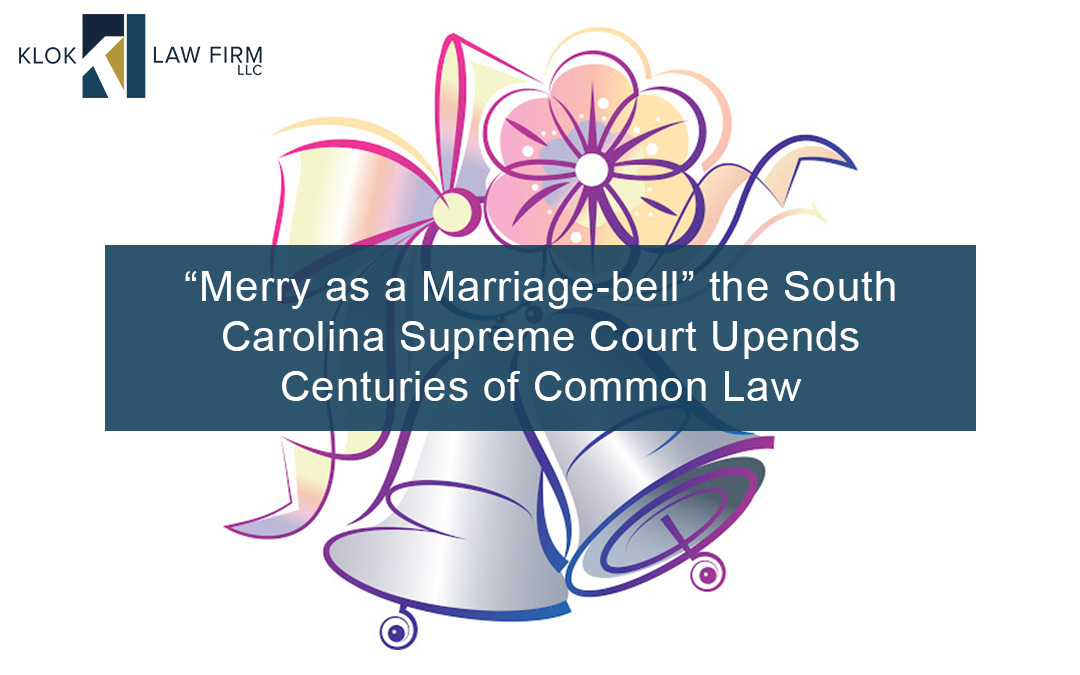“Merry as a Marriage-bell” the South Carolina Supreme Court Upends Centuries of Common Law
Lord Byron in Childe Harold’s Pilgrimage could provide no more happy a description than the ringing of a marriage bell.[1] Yet, not every marriage over the years has been attended by the solemnities and festivities that typically accompany a marriage.
Marriages formed without license or ceremony are common-law marriages, and common-law marriages were chiefly associated with the English people and their descendants. As to other nations, “no marriage could be concluded without some formal ceremony . . . after the Council of Trent in all Western countries except those in the sphere of the English common law.”[2] Under the Canon Law prevailing in England, marriage was formed by the simple consent of the parties, even when that consent was exchanged secretly and without any ceremony, so long as the consent for marriage was accompanied by verbal affirmation of the marriage partners.[3]
As such, and as regards the development of the law of marriage in the United States, “[t]he Colonists took out with them the Common Law of England . . . [a]nd a marriage good at Common Law will be valid although contravening such local law, unless such local law creates an express statutory nullity.”[4] In his renowned Commentaries, Sir William Blackstone describes marriage as the “second private relation of persons,” and inherently includes marriage at common law among valid marriages, stating that “the law treats it as it does all other contracts; allowing it to be good and valid in all cases, where the parties at the time of making it were, in the first place, willing to contract; secondly, able to contract; and, lastly, actually did contract, in the proper forms and solemnities required by law.”[5]
So, a jury instruction from the early 1900s stated on the subject that,[6]
the issuance of a license is not necessary to constitute a valid common-law marriage. A common-law marriage exists when the man and woman enter into an agreement to become husband and wife, and in pursuance of such agreement do live together and cohabit as husband and wife and hold each other out to the public as husband and wife. Said agreement to become husband and wife may be express or implied.
When the Florida Supreme Court addressed the subject of common-law marriage in the 1940s, the Court noted, “some of the states recognize a marriage without ceremony. Many of them, however, have either abolished this form of contract or have refused to countenance it in the first instance, but it is approved or tolerated in Florida. . . . We can give no logical reason although we will not attempt to abolish it by judicial fiat.”[7]
Like the Supreme Court in Florida, South Carolina courts have long disapproved of changes being made to the law through “judicial fiat,” the arbitrary decree of a court,[8] noting “the court could not by judicial fiat legislate a right or a duty.”[9] Judicial fiat was disapproved of by South Carolina courts as being judicial action that was beyond the right of a court to decree, even when the repudiation of a common-law rule would be done because the rule appeared to be illogical, undesirable, or plainly wrong.[10] And, even as recently as 2009, the Supreme Court of South Carolina continued to refuse to decide cases by judicial fiat, because to do so would result in judicial legislation that would be at odds with statutes enacted by the South Carolina Legislature.[11]
Something appears to have changed at the South Carolina Supreme Court.
On July 24, 2019, in the case of Stone v. Thompson, the South Carolina Supreme Court issued a stunning decision (which on October 16, 2019, the Court declined to reexamine), prospectively abolishing common-law marriage throughout the state of South Carolina.[12] Perhaps more stunning an aspect of the Court’s decision than the abolition of common-law marriage, if possible, was that the Court also abolished its prior refusal to decide cases by judicial fiat. As part of the Court’s justification in the Stone v. Thompson case for abolishing the recognition of common-law marriage, the Court stated that the “common law changes when necessary to serve the needs of the people. . . . [and] when it has become apparent that the public policy of the State is offended by outdated rules of law. . . . [those outdated rules] may be removed by common-law mandate [of the courts], regardless of tacit recognition by our legislature.”[13]
So, the new consensus at the South Carolina Supreme Court, embraces “judicial legislation,” which was previously described by the South Carolina Supreme Court as an impermissible “flaunting of the law as written by the Legislature.”[14] In adopting this decisional change to now embrace judicial action that rewrites the common law, the Court appears to give no weight to its prior holdings that pronounced previously well-accepted explanations, such as the following, of the importance of maintaining a separation of powers:”[15]
The preservation of a separation of powers has been a basic tenet of democratic societies at least since Baron de Montesquieu warned that “[t]here would be an end of everything, were the same man or the same body, whether of the nobles or of the people, to exercise those three powers, that of enacting laws, that of executing the public resolutions, and of trying the causes of individuals.” Consistent with this notion, the South Carolina Constitution requires the branches of government be “forever separate and distinct from each other, and no person or persons exercising the functions of one of said departments shall assume or discharge the duties of any other.”
Two factors may undergird the South Carolina Supreme Court’s decision to abolish common-law marriage in the state. One was that, as Ashley Hedgecock noted in 2007, “South Carolina [was] among a dwindling minority of jurisdictions that recognize common law marriage.”[16] In fact, the Stone v. Thompson Court mentioned the Ashley Hedgecock article in its decision.[17] The other factor relied upon by the Stone v. Thompson Court appears to be that in modern America “demographic shifts have altered what was previously thought of as ‘marriage’ and ‘family’ and what elements are, and should be, in play in the dissolution of marital and non-marital relationships. . . . [And a concern that, if] legal tests and remedies do not keep some pace with the reality of living arrangements, family law runs the risk of becoming a source of unfairness rather than a mechanism for achieving equity.”[18]
In Stone v. Thompson, the South Carolina Supreme Court pronounced that the recognition of common-law marriage was no longer a necessary factor for the Courts to consider in a Family Court case, in part because “circumstances creating a need for the doctrine are not present in today’s society.”[19]
Regardless of the reason for the new law announced by the South Carolina Supreme Court abolishing common-law marriage, the result is that “no individual may enter into a common-law marriage in South Carolina after the date of this opinion [July 24, 2019].”[20] In the view of the South Carolina Supreme Court, parties coming before the courts of the state should not be treated as married unless they have obtained a ceremonial marriage through civil or religious authorities, regardless of whether the parties intended to be in a committed relationship together, lived together, raised children, and engaged in mutually beneficial activities.[21]
A few issues remain.
If parties, even now after the Stone v. Thompson decision, enter into a common-law marriage in a state that recognizes the same before coming to South Carolina, South Carolina courts would have to still honor that common-law marriage because of the Full Faith and Credit Clause of the United States Constitution (Art. IV, § 1). Nothing in the Stone v. Thompson decision alters the obligations of South Carolina courts to uphold the Full Faith and Credit Clause or the longstanding judicial rule that “a marriage that is good in the country where performed (lex loci) is good elsewhere.”[22]
So, if parties come to South Carolina after having established a common-law marriage that was recognized in their prior “lex loci” – similar to how the parties in the case of Travers v. Reinhardt came to the courts in Washington, D.C., after establishing a common-law marriage in New Jersey – South Carolina must recognize that common-law marriage, despite having abolished such recognition through the 2019 judicial fiat of the South Carolina Supreme Court in the Stone v. Thompson decision.
And, additionally, the 2019 Stone v. Thompson decision does not eliminate the need of the courts to address the repercussions of cohabitation that takes place in the absence of a state sanctioned marriage. Cohabitation outside of marriage is not likely to disappear any time soon. In fact, “[a]ll trends point toward an increase in cohabitant cases. Half the American Academy of Matrimonial Lawyers Fellows polled in February 2011 noted a spike in the number of suits between former cohabitants, and 39 percent noted an increase in the number of cohabitation agreements.”[23]
As early as 1911, the Supreme Court of South Carolina opposed the harsh doctrine applied in other states that dictated the mandate that “where the relation began as meretricious, it cannot be converted into a marriage.”[24] And while one might question the use of the term “meretricious” instead of the more current phrase of “committed intimate relationship,”[25] South Carolina law only prevents recovery of compensation based on an intimate relationship if those relations are illegal or contrary to public policy.[26] Given the reasoning set forth in the Stone v. Thompson case, which holds that the changing culture and mores of the day provide a basis for changes to be made in the law relied upon by the courts, South Carolina cases that formerly barred compensation based on “meretricious” relationships should now be read as supporting such recoveries.
As a prelude to such findings in future cases, that a committed intimate relationship that does not rise to the level of state-sanctioned marriage may nonetheless require an equitable division when the relationship ends, in 1991 the Supreme Court of South Carolina recognized that “circumstances surrounding [a] relationship [may] make it tantamount to marriage.”[27] And, the present state of property division following the 2019 Stone v. Thompson decision that effectively barred property division in a Family Court case with aspects of a committed intimate relationship, leaves unaddressed the possibility of a party calling for an equitable accounting or other equitable relief between such individuals to be determined by the courts. The most straightforward case would be a basic action for an accounting, which is an action in equity.[28]
As a final matter to consider regarding the impact of the 2019 Stone v. Thompson decision, “the common law of England is of force in [South Carolina], except where it has been abrogated or modified by legislative enactment.”[29] So, the Stone v. Thompson Court left unresolved for another day the question of how a common-law marriage recognized under the common law of England, and not abrogated or modified by legislative enactment, can nonetheless not be recognized in a Family Court action.
[1] Baron George Gordon Byron, Childe Harold’s pilgrimage: a romaunt at 134, Canto III, Stanza XXI (London, John Murray: 1869).
[2] Marvin B. Sussman, Sourcebook in Marriage and the Family at 550 (3d ed. 1959).
[3] Sir W. N. M. Geary, The Law of Marriage and Family Relations, a manual of practical law at 4 (1892)(“either per verba de presenti or per verba de futuro subsequente copula”).
[4] Id. at 115.
[5] Sir William Blackstone, Commentaries on the laws of England – Volume 1, at 433 (1771).
[6] Albert W. Brickwood, LL.B., Brickwood’s Sackett on Instructions to Juries – Volume 1, at 502, § 704 (3d ed. 1908).
[7] McClish v. Rankin, 14 So.2d 714, 717 (Fla. 1943).
[8] Fiat [<judicial fiat>], Black’s Law Dictionary (9th ed. 2009).
[9] Page v. Winter, 126 S.E.2d 570, 577, 240 S.C. 516, 528 (S.C. 1962).
[10] Id., 126 S.E.2d at 571.
[11] Harris v. Anderson County Sheriff’s Office, 673 S.E.2d 423, 426, 381 S.C. 357, 363-64 (S.C. 2009).
[12] Stone v. Thompson, 833 S.E.2d 266 (S.C. 2019).
[13] Stone v. Thompson, 833 S.E.2d 266, 269 (S.C. 2019).
[14] Tedars v. Savannah River Veneer Co., 25 S.E.2d 235, 238, 202 S.C. 363, 371 (S.C. 1943).
[15] South Carolina Public Interest Foundation v. South Carolina Transp. Infrastructure Bank, 744 S.E.2d 521, 525-26, 403 S.C. 640, 649 (S.C. 2013).
[16] Ashley Hedgecock, Untying the Knot: The Propriety of South Carolina’s Recognition of Common Law Marriage, 58 S. C. L. Rev. 555 (2007).
[17] Stone v. Thompson, 833 S.E.2d 266, 268 (S.C. 2019).
[18] Marshal S. Willick, The Evolving Concept of Marriage and Coming Convergence of Marital and Non-Marital Property and Support Law, 19 Nev. Law. 6 (2011).
[19] Stone v. Thompson, 833 S.E.2d 266, 269 (S.C. 2019).
[20] Stone v. Thompson, 833 S.E.2d 266, 270 (S.C. 2019).
[21] Stone v. Thompson, 833 S.E.2d 266, 274 (S.C. 2019).
[22] U.S. GPO, United States Constitution – Annotated at 899 (2014). See also Travers v. Reinhardt, 205 U.S. 423, passim (1907).
[23] Marshal S. Willick, The Evolving Concept of Marriage and Coming Convergence of Marital and Non-Marital Property and Support Law, 19 Nev. Law. 7 (2011).
[24] Davis v. Whitlock, 73 S.E. 171, 175, 90 S.C. 233, 246 (S.C. 1911).
[25] See, e.g., Morgan v. Briney, 200 Wn.App. 380, 384, 403 P.3d 86, 89 (2017)(noting use of “committed intimate relationship” or “CIR” as preferred term for such relationships).
[26] Grant v. Butt, 17 S.E.2d 689, 198 S.C. 298, passim (S.C. 1941).
[27] Bryson v. Bryson, 553 S.E.2d 493, 496, 347 S.C. 221, 226 (S.C.App. 2001). See also Love v. Love, 626 S.E.2d 56, 367 S.C. 493 (S.C.App. 2006).
[28] Historic Charleston Holdings, LLC v. Mallon, 381 S.C. 417, 427, 673 S.E.2d 448, 453 (2009).
[29] State v. Wilson, 161 S.E. 104, 110, 162 S.C. 413, 428 (S.C. 1931).






